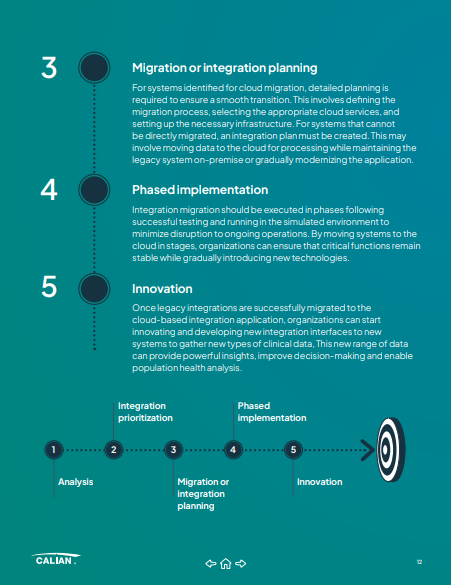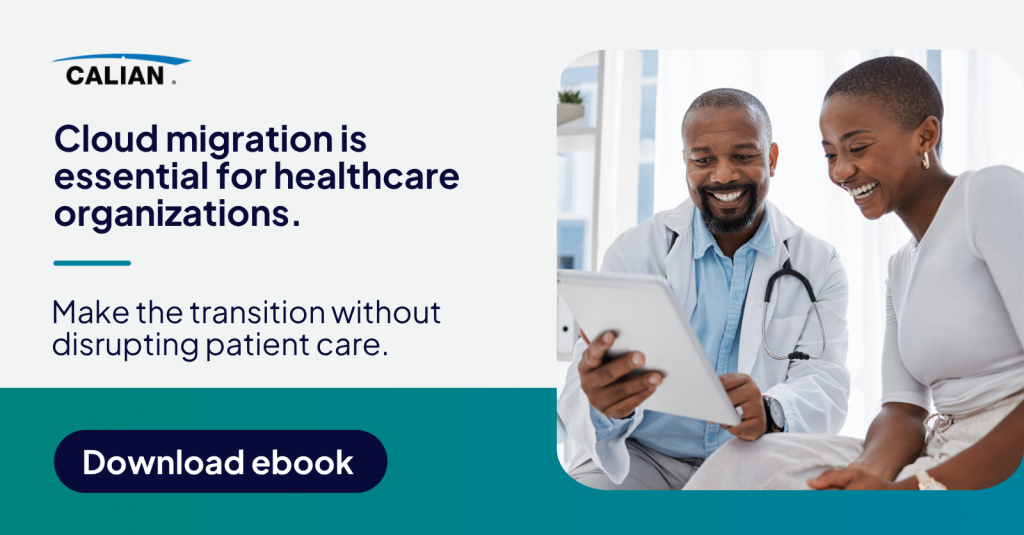For healthcare organizations, migrating to the cloud is no longer just an option—it’s a necessity for achieving greater efficiency, scalability and robust security in their IT infrastructure. However, this transition is more than a technical upgrade; it’s a fundamental shift in how care is delivered and operations are managed.
For healthcare CIOs and IT leaders, successful migration requires a thoughtful approach that balances innovation with security and compliance, integrates legacy systems and aligns with organizational goals. From navigating data privacy regulations to overcoming implementation roadblocks, each step must be carefully planned to minimize disruption and maximize value.
This blog offers a step-by-step guide to building a strong foundation for a successful cloud migration, with insights on how to anticipate common challenges, craft an effective strategy and harness the power of scalable IT systems to support long-term success.
Why cloud migration is essential for healthcare
As healthcare data management grows increasingly complex, adopting a cloud-first approach to streamline integrations has become the clear solution for organizations. Today, healthcare generates over 30 per cent of the world’s data, according to RBC Capital Markets—a figure that’s only expected to rise. As data volumes surge, the need for scalable and future-ready infrastructure has never been more critical.
Legacy on-premises systems often struggle to meet the demands of modern healthcare, lacking the flexibility and efficiency needed to support and process growing clinical and operational needs. In contrast, evolving to the cloud offers a range of benefits:
- Scalability: Dynamically scale computing resources up or down based on real-time demand.
- Enhanced security: Leverage enterprise-grade security protocols to protect sensitive patient information.
- Improved reliability: Minimize downtime and maintain continuity of care with high-availability, redundant architectures.
- Cost efficiency: Shift from capital-intensive infrastructure to a more flexible operational expenditure model that optimizes IT spending.
- Innovation enablement: Unlock advanced capabilities like AI, machine learning and predictive analytics to drive digital transformation.
To ensure this transition is structured, secure and aligned with business goals, organizations can adopt the Cloud Adoption Framework (CAF) as a guiding framework. CAF provides a structured approach to cloud adoption that includes best practices, tools and guidelines to align technical decisions to business objectives and build cloud environments that are optimized for healthcare’s unique demands. This ensures that cloud adoption is business-aligned, secure and operationally sustainable, avoiding ad hoc migration decisions that may lead to downstream inefficiencies or risk.
So what are the key steps to establishing a solid foundation for modernization?
Step 1: Conduct a comprehensive system analysis
Before initiating the transition, it’s critical to conduct a comprehensive audit of your organization’s current IT infrastructure. This detailed analysis plays a crucial role as the foundation of your migration strategy, helping to identify and prioritize key workloads such as:
- High-priority systems: These applications are critical to patient care, daily operations and overall efficiency. Prioritizing them during migration helps ensure seamless service delivery and minimizes the risk of disruptions.
- Legacy systems: Older systems can be challenging to migrate due to incompatibility with modern cloud technologies. Identifying them early helps you plan upgrades, replacements or specialized solutions for a smooth transition.
- Improvement opportunities: Cloud integration provides key advantages, including enhanced scalability, improved access to data and faster disaster recovery. By prioritizing mission-critical systems, organizations can maximize value and ensure the most impactful areas of their operations are optimized.
This assessment lays the groundwork for a successful cloud migration. By aligning IT priorities with organizational goals, you can ensure the transition supports critical workflows and patient services. Strategic planning and prioritization can help ensure a seamless migration process that positions your organization for success and maximizes the return on your cloud investment.
Step 2: Prioritize integrations
One of the most critical phases of a successful cloud migration is deciding which systems to move first—and how to move them. Not all applications should be treated equally, especially in complex healthcare environments where clinical, administrative and operational systems are tightly interwoven. Prioritizing integrations thoughtfully ensures continuity of care, minimizes disruption and maximizes early returns on cloud investments.
Start by assessing your current IT landscape and focusing on mission-critical applications—those essential to patient care, compliance and daily operations. This includes electronic health records (EHRs), lab information systems, patient scheduling tools and billing platforms. Prioritizing these systems helps reduce risk, supports core workflows and ensures that key services remain uninterrupted during migration.
Next, evaluate interdependencies. Some systems may rely on others for data exchange or authentication, making it important to group and sequence migrations logically. Applications with fewer dependencies and simpler data structures often serve as low-risk starting points to build momentum and validate your migration strategy.
Step 3: Develop a detailed migration plan
Once dependencies are prioritized, the next step involves creating a detailed migration roadmap to ensure a smooth and efficient transition. Roadmap development should include:
- Selecting the right cloud service provider: Evaluate options like Microsoft Azure, AWS or Google Cloud based on your business needs, scalability, budget and the support and services they offer. It’s also important to assess each provider’s support offerings and training resources to ensure teams are upskilled to operate in the new cloud environment.
- Determine the most appropriate modernization strategy: The 5R’s of application modernization (rehost, refactor, rearchitect, rebuild and replace) provide a helpful framework for determining the best modernization approach for each application based on its complexity or cloud compatibility. For systems that cannot be directly migrated, consider integrating legacy platforms with cloud-based applications through middleware, gradually redesigning the application over time using cloud-native technologies, or swapping the existing system for a cloud-native SaaS alternative.
- Defining the migration process for each system: Break the migration into phases with clear timelines, milestones, and deliverables. Prioritize critical systems, determine dependencies and decide which applications to migrate first.
- Preparing the necessary IT infrastructure for the transition: Ensure your infrastructure can handle the migration with adequate bandwidth, storage and compatible hardware or software. Set up testing environments, back up data and equip your team with the tools and knowledge for a smooth transition.
A clear and well-planned migration can ensure unexpected downtime is minimized while mission-critical systems remain operational throughout the transition.
Step 4: Implement integration migration in phases
A successful cloud migration in healthcare requires more than just technical execution—it demands a thoughtful, phased approach that minimizes risk and disruption. Rather than opting for a “big bang” strategy, where all systems are migrated at once, organizations should adopt a phased-approach migration that executes in stages and at the organization’s preferred pace.
Start with low-risk applications with fewer dependencies, such as scheduling tools, before moving on to mission-critical systems like EHRs. This cadence allows teams to learn, refine and build confidence at every stage. Additionally, pairing each phase with rigorous testing in simulated environments helps ensure system stability and minimizes the risk of downtime.
At Calian, we champion this measured strategy through our continuous cloud migration (CCM) model. Optimized for healthcare, CCM focuses on incremental success—starting with lower-risk integrations and methodically building toward full cloud adoption without compromising data security and care delivery. With the help of integration platform as a service (iPaaS) tools like Corolar Cloud, organizations can bridge on-premises and cloud environments to ensure that data continues to flow across the organization throughout the entirety of the transition period.
Step 5: Unlock innovation after migration
Once foundational systems are successfully migrated, healthcare organizations can begin unlocking the full potential of the cloud to accelerate innovation. Cloud technologies empower providers to:
- Handle increasing volumes of healthcare data
- Gain valuable, real-time insights across devices and locations to improve decision-making
- Improve integration across systems to create a unified view of patient records
- Adopt AI and ML to enable predictive analytics, early diagnosis and personalized treatment development
- Automate tasks to free up clinician and IT time
- Invest in innovation without overprovisioning resources
- Monitor population health with advanced analytics
- Deploy updates and new features rapidly without compromising system stability
These transformative advancements are only possible with robust computing capabilities enabled with cloud infrastructure, underscoring the importance of a strong foundation for the long-term success of your migration.

Additional considerations for your migration strategy
While developing your cloud migration strategy, factoring these additional considerations into the planning phase will help ensure a smoother transition and stronger alignment across your organization:
- Choosing the right deployment model. Whether it’s a public, private or hybrid cloud, your deployment model should align with your organization’s goals, compliance requirements and risk tolerance. Each option offers different levels of control, scalability, and security—making it essential to select the model that best supports your long-term vision.
- Enhancing your overall security posture: Healthcare organizations should enhance their overall security posture during cloud migration to proactively manage risks, protect sensitive patient data and meet regulatory requirements. The Microsoft Cloud Adoption Framework emphasizes embedding security early in the migration process to ensure resilient, compliant and well-governed cloud environments.
- Enabling collaboration across teams. Cloud migration touches every corner of a healthcare organization. Bringing together IT, clinical and administrative stakeholders early in the planning process ensures that the strategy is aligned with both operational needs and patient care priorities.
- Planning for ongoing management. Migration isn’t a one-time event—it’s an ongoing journey. Post-migration, continuous monitoring, maintenance and optimization are key to ensuring performance, security and scalability over time.
By addressing these considerations up front, healthcare organizations can better position themselves for a smooth, secure and future-ready cloud transition.
Your cloud journey starts here
From enhancing scalability and security to enabling mission-critical innovations like AI and real-time data analytics, the cloud offers healthcare organizations a path to greater efficiency, agility and resilience.
Comprehensive planning, alignment with regulatory requirements, and continuous monitoring are essential to ensure a successful transition and long-term sustainability in the cloud. With the right strategy and trusted partners, healthcare providers can unlock the full potential of the cloud, championing innovation while advancing their mission to deliver high-quality, accessible healthcare services.
If your healthcare organization is ready to make the leap to the cloud, we’re here to guide you. Contact us to learn more about our cloud modernization solutions and how we can help your organization succeed in your migration journey.
Plus, get your free copy of our playbook for healthcare integrations to help make your cloud migration journey simple, seamless and secure.
